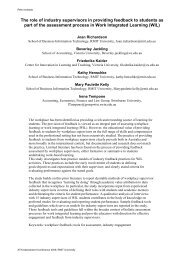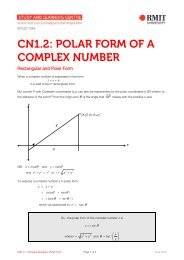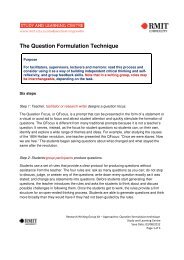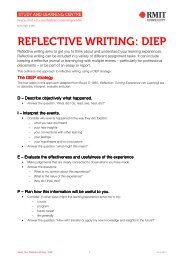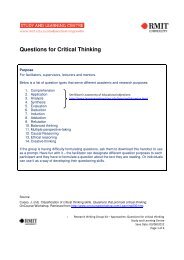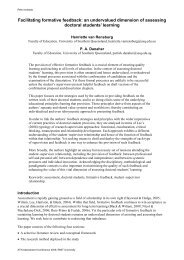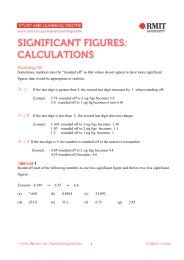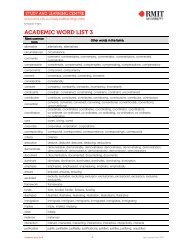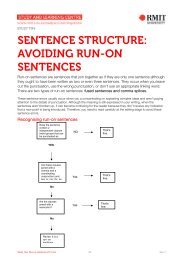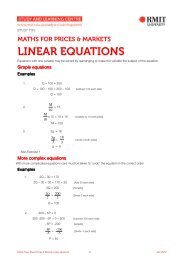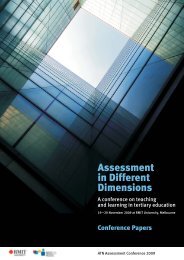student feedback and leadership - Office for Learning and Teaching
student feedback and leadership - Office for Learning and Teaching
student feedback and leadership - Office for Learning and Teaching
You also want an ePaper? Increase the reach of your titles
YUMPU automatically turns print PDFs into web optimized ePapers that Google loves.
Part A: Developing a Distributed Leadership Model - Secton 3: Building Leadership Capacity<br />
––<br />
the existence of the power <strong>and</strong> responsibility to take <strong>leadership</strong><br />
in improving <strong>student</strong> <strong>feedback</strong> at the appropriate level of the university<br />
––<br />
<strong>student</strong> responsibility in developing <strong>leadership</strong> of their own learning<br />
––<br />
the importance of providing adequate support (such as mentoring)<br />
of new academics.<br />
2. There is a need to have supportive systems <strong>and</strong> infrastructure<br />
in which learning <strong>and</strong> teaching occurs. This was particularly illustrated<br />
in the plenary <strong>feedback</strong> that identified obstacles to the effective use<br />
of <strong>student</strong> <strong>feedback</strong> including university facilities <strong>and</strong> resources <strong>and</strong> staff<br />
concern about the survey instrument. This confirmed the view emerging<br />
from the ART analysis of data that, in addition to a multi-level <strong>leadership</strong><br />
approach to <strong>student</strong> <strong>feedback</strong>, there is need <strong>for</strong> multi-function <strong>leadership</strong><br />
engagement. It is only through such a <strong>leadership</strong> approach that shared<br />
underst<strong>and</strong>ing <strong>and</strong> meaning can be developed. This led to recognition<br />
that <strong>leadership</strong> in the use of <strong>student</strong> <strong>feedback</strong> needs to extend beyond<br />
an exclusive focus on the relationship between the <strong>student</strong>s <strong>and</strong> teacher,<br />
to the interrelated roles of many participants across the university. This<br />
was summarised by the DVC(A) in his concluding remarks at the Plenary<br />
that:<br />
the discussion rein<strong>for</strong>ced the view that responding to <strong>student</strong><br />
<strong>feedback</strong> is to ensure that there is both a shared underst<strong>and</strong>ing<br />
<strong>and</strong> congruent action across the university. It is not simply a teacher<br />
responsibility but rather involves all sectors of the University at<br />
multiple levels.<br />
3. There is a need <strong>for</strong> leaders at all levels to demonstrate by the action they<br />
take their commitment to implementing university policies <strong>and</strong> procedures<br />
in relation to <strong>student</strong> <strong>feedback</strong>. A further issue that emerged from ART<br />
activity was the need to ensure that <strong>leadership</strong> action is congruent with<br />
intent if it is to develop shared underst<strong>and</strong>ing <strong>and</strong> meaning. This was<br />
illustrated by the initial challenge faced by one of the ARTs in attempting<br />
to encourage members to share <strong>student</strong> <strong>feedback</strong> about their individual<br />
teaching practice at a time when the Head of School had announced that<br />
there was the need to reduce the number of teaching staff in the School.<br />
This experience suggests a particular challenge <strong>for</strong> Heads of School <strong>and</strong><br />
senior leaders of ensuring that using <strong>student</strong> <strong>feedback</strong> to improve learning<br />
<strong>and</strong> teaching practice is separated from per<strong>for</strong>mance management<br />
of staff.<br />
Page 43



